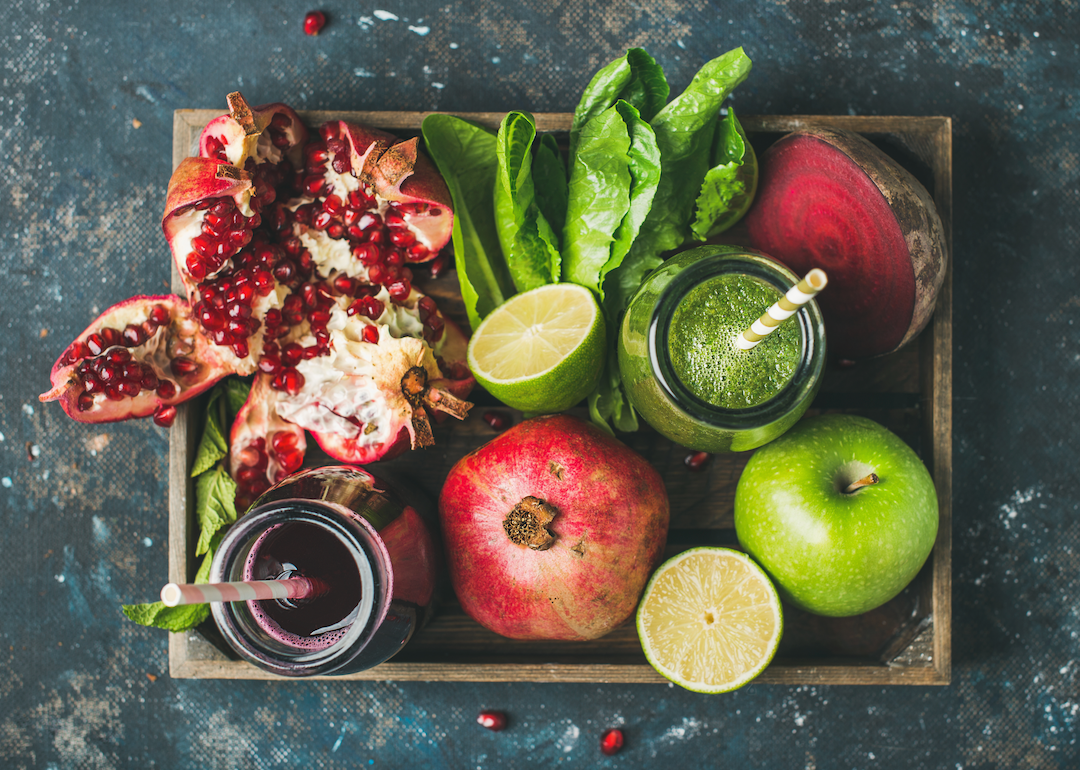
Superfoods that have been used by other cultures for generations
Superfoods that have been used by other cultures for generations
As American consumers steer more and more toward cleaner eating, even fast-food restaurants like White Castle and Burger King are rolling out health-savvy options. Superfoods—nutritious options with a variety of benefits and nutrients—are becoming more popular than ever. You don’t have to wait in long lines at the newest locally harvested food stand or shell out more than $10 to beef up on superfoods in a salad, though. Many of the most nutritious foods are readily available at local markets and have been used in cuisines around the world for generations.
Did you know that a certain leafy green was made cool by the French and in Asia before it became a buzzword in Brooklyn? Or that pumpkins, before becoming a symbol of Halloween, were devoured with regularity in Mexico? Even one of the most American of all fruits has histories just as rich (and tasty) throughout Europe.
Stacker calls out 25 superfoods that have been used by other cultures for generations. Some of the entries date back thousands of years, so we explore when these foods were first discovered, how they were utilized in dishes way back when, and the health benefits that have helped them persist over centuries. Indulgences like dark chocolate and yogurt have long been consumed across the globe for more than just a fine dessert—they’ve been an almost daily staple in maintaining a healthy lifestyle. Click through to find out the real benefits of Popeye’s favorite vegetable, what the namesake of his love interest means to Italian cuisine, and why chia seeds were used by Central American cultures for centuries.
Read on to find out which foods you might want to put on your next shopping list—or which foods you already have in your kitchen—with Stacker's list of 25 superfoods.
You may also like: Environmental impact of 20 foods
Kale
You might think kale is as trendy as Lululemon pants and Citibikes, but this leafy nutrient has been a popular ingredient for centuries. The French consumed kale steadily before the 20th century. Even earlier, before there were fine restaurants and aggressive farming routines, Mediterannean and Asian cultures used the leaves regularly in meals.
Ginger
More than a supplement or a tasty ingredient in carbonated drinks, culinary masters have boasted the health benefits of ginger for a while. Studies have shown ginger helps fight body fat, but even before this research emerged, Asian cultures used the root as a staple of their diet. Today, ginger can still be found heavily in modern Asian cuisines.
Avocado
More than the key component of guacamole, avocados have reportedly been consumed by Central Americans for 10,000 years. The Aztecs were among those who believed avocados boasted supernatural powers if eaten; though researchers have not confirmed that.
Pumpkin
The pumpkin is loaded with nutrients; it provides fiber, vitamin A, and potassium. Pumpkins are believed to have first been grown in Mexico, but Americans have adopted them as a staple of family holiday meals for more than a century.
Seaweed
For centuries the Japanese have included seaweed as a key ingredient in meals. Seaweed has also been used as a plant fertilizer, in medical treatments, and as a dietary supplement. Today, seaweed is regularly consumed around the world in Japanese cuisine.
Oranges
Citrus fruits like the orange are believed to have been first used in the Himalayas. As the orange evolved over time, Brazil became one of the world’s largest producers of the fruit, along with China and the United States. Oranges are notable for their high amount of vitamin C.
Eggs
The egg might be one of the more controversial superfoods. Loaded with nutrients, many diners forego the yolk to eat only the healthier white of an egg. However, some studies show that eggs—which have been eaten around the world for centuries—reduce weight and are especially beneficial for children.
Dark chocolate
Dark chocolate was first used as a beverage in Central and South America almost 4,000 years ago. Today, Europe consumes an estimated 50% of the world’s chocolate. Some research shows that dark chocolate can lower blood pressure and may reduce heart disease.
Wheatgrass
Wheatgrass is one of the rare superfoods to provide vitamin B12. Ancient Egyptians were among the first to utilize wheatgrass in diets. Later, scientists found that it benefits the digestive system and can even possibly prevent hair loss.
Sweet potato
There is debate over whether sweet potatoes originated in the Americas or in India, but today China grows more of them than any other country. Sweet potatoes are also a staple of diets throughout Africa thanks to their richness of vitamins and antioxidants. Americans can usually find them on the table at Thanksgiving dinner.
Yogurt
Yogurt first became a food of choice in 10,000 B.C. Digestive problems associated with dairy have troubled humans for centuries, but yogurt is easier to consume than most products. Turkey has long been one of the biggest consumers of yogurt—the word itself is of Turkish origin.
Acai
Superfood connoisseurs can thank Brazilians for the growing presence of acai. The berries originated in the Amazon and were consumed more so in their natural form than in bowls and smoothies, as how many Americans have come to know them. Acai is famous for its antioxidant properties.
Spinach
Popeye is not the only person who loves spinach. Various Asian cultures have been fond of these green leaves even before formal records were kept. Full of iron, spinach strengthens bones and helps blood circulation and health.
Pomegranate
Pomegranate first popped up near the Himalayas and has been a regular option on diets in Asia for centuries. Modern dishes include pomegranate in salads or with meat, while recently the fruit—in solid and juiced form—has taken off in the Western hemisphere thanks to its levels of vitamins A, B, and C.
Oatmeal
The Egyptians and Chinese may have been the first to consume oatmeal, but the Scots have entire festivals dedicated to the dish. As NPR’s Tom Harte noted, Samuel Johnson said oats appear to support the people of Scotland. Oatmeal is filling, full of fiber, and can help fight heart disease.
Olive oil
Olive oil is loaded with vitamin E and may help reduce the risk of heart disease. A staple of Italian cuisine for centuries, olive oils can be as revered as fine wines—Tuscany oils have a peppery finish, while Puglia is known for its grassy and richer-tasting oil.
Brussel sprouts
Brussel sprouts are popular in Belgium, but the Netherlands actually leads the world in the production of the tiny cabbages. These veggies can be cooked a variety of ways—Flemish style is popular in Belgium, where they are buttered, sauteed, and browned. Alone, Brussel sprouts are chock-full of nutrients, antioxidants, and fiber.
Fish
Coastal cultures around the world have used fish as a key part of diets since almost the beginning of human nature. Over time, it became known that fish is rich in protein and omega-3 fatty acids, which can help battle heart disease.
Quinoa
First recognized for its nutritional benefits by South American countries, quinoa has seen a boon in popularity in North America of late. Today, it’s often mixed with a plethora of vegetables in a bowl and is consumed for its protein content and amino acids.
Green tea
This Chinese drink may be the most well-known superfood in liquid form. Green tea is rich in antioxidants and often consumed to combat colds. Some accounts believe green tea was first ingested regularly almost 5,000 years ago.
Almond milk
Almond milk and other nut-originated milk have become popular in America in recent decades, but they were first used regularly in the Middle East. The low caloric content and dairy-free nature of a nut milk makes it a popular choice for those who are lactose intolerant, vegan, or just looking for a healthier option.
Blueberries
Berries, in general, are high in fiber, as well as a sweet way to take in nutrients that help combat diseases and to stock up on antioxidants. Blueberries, in particular, are native to North America, but are quite popular in South America, as well.
Soybeans
Soybeans were first consumed in Asia but have become a superfood of choice around the world. Soy sauce is probably the most well-known usage of soybeans in Chinese cuisine, but aside from flavoring other dishes, soybeans are high in fiber and protein.
Chia
Chia seeds are known for more than just hawking kitschy plants on TV commercials. Chia seeds, a Central American staple, are stocked with omega-3 fatty acids. They also are a good source of protein and minerals, and have become a popular ingredient in puddings.
Apples
Apples first came to prominence in Central Asia but now are a worldwide superfood of choice. Particularly in America, apples are associated with a healthy lifestyle, thanks to their dietary fibers and antioxidants. And while there may be few things as American as apple pie, Europeans have quite a claim to creating apple-based desserts, from their savory strudels to French apple cakes.
You may also like: Environmental impact of 20 foods



